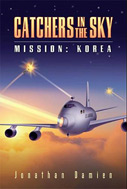By Rolando Garcia
Natural Sciences and Mathematics Communications
It’s a story that could presage tomorrow’s headlines - a military confrontation with North Korea that puts to the test a new Star Wars-type weapons system designed to knock ballistic missiles from the sky.
This might sound like the latest political thriller from Tom Clancy, but the story is actually the work of an NSM alum whose experience developing cutting-edge laser and intelligence-gathering systems for the U.S. Air Force provided material for his third novel.
“Catchers in the Sky” – a self-published book by John Gonglewski – debuted in August and can be purchased through Amazon.com.
Gonglewski, who uses the pen name Jonathan Damien, graduated from UH with a Ph.D. in mathematics in 1986. He is a research physicist and program manager at the Air Force Research Lab in New Mexico.
In the late 90s, Gonglewski was part of a team that proposed and designed a laser beam mounted on a 747 jet that would be powerful enough to shoot down a missile 200 miles away. The Air Force still is testing the airborne laser, but in Gonglewski’s book there already is a working prototype.
 Gonglewski’s work designing one of the Pentagon’s most revolutionary weapons systems, combined with his fascination with the simmering tensions on the Korean peninsula and his longtime interest in fiction writing, inspired him to pen this novel, Gonglewski said. Gonglewski’s work designing one of the Pentagon’s most revolutionary weapons systems, combined with his fascination with the simmering tensions on the Korean peninsula and his longtime interest in fiction writing, inspired him to pen this novel, Gonglewski said.
The technology itself is groundbreaking and could protect Americans from ballistic missiles carrying nuclear warheads launched from Iran, North Korea or other hostile countries.
The apparatus to generate the laser occupies most of the 747, and the plane could be dispatched to potential hot spots. While cruising in international airspace, the plane could shoot down missiles while they are in the vulnerable boost phase, Gonglewski said.
The book doesn’t read like a technical manual, however, and he worked hard to cut out anything that would bore a general reader, Gonglewski added.
Instead, Gonglewski takes readers into the world of the plane’s crew as well as that of military scientists, politicians and diplomats in a fast-moving story of a decades-old conflict about to explode.
Drawing upon his visits to North Korea, as well as accounts from North Korean defectors, Gonglewski also tries to paint a picture of what life is like for those living in an impoverished, 1984-style dystopia.
“Aside from the brain-washing, there’s lots of humanity there, lots of yearning and longing,” Gonglewksi said.
The novel has won rave reviews from leading military experts and diplomats for its suspense and realism. More than 1,000 copies have sold so far, and Gonglewski has high hopes for the book – he even plans on pitching it to Hollywood producers.
Although mathematicians do not often dabble in fiction, Gonglewski said he has long enjoyed military thrillers from well-known authors such as Clancy, Dale Brown and Larry Bond and believed he had a unique story to tell.
Designing revolutionary weapons systems for the Pentagon was not Gonglewski’s original plan upon graduating from UH, but the degree can open doors to all sorts of opportunities, he said, and he still has fond memories of his time in UH’s math department.
“It was a happening place in the late 80s and still is,” Gonglewski said, with “students spending quality time with faculty, bridge parties, afternoon colloquiums, and everyone got good jobs at the end.”
To learn more about the book visit the author’s Web site, www.jonathandamien.com. |

